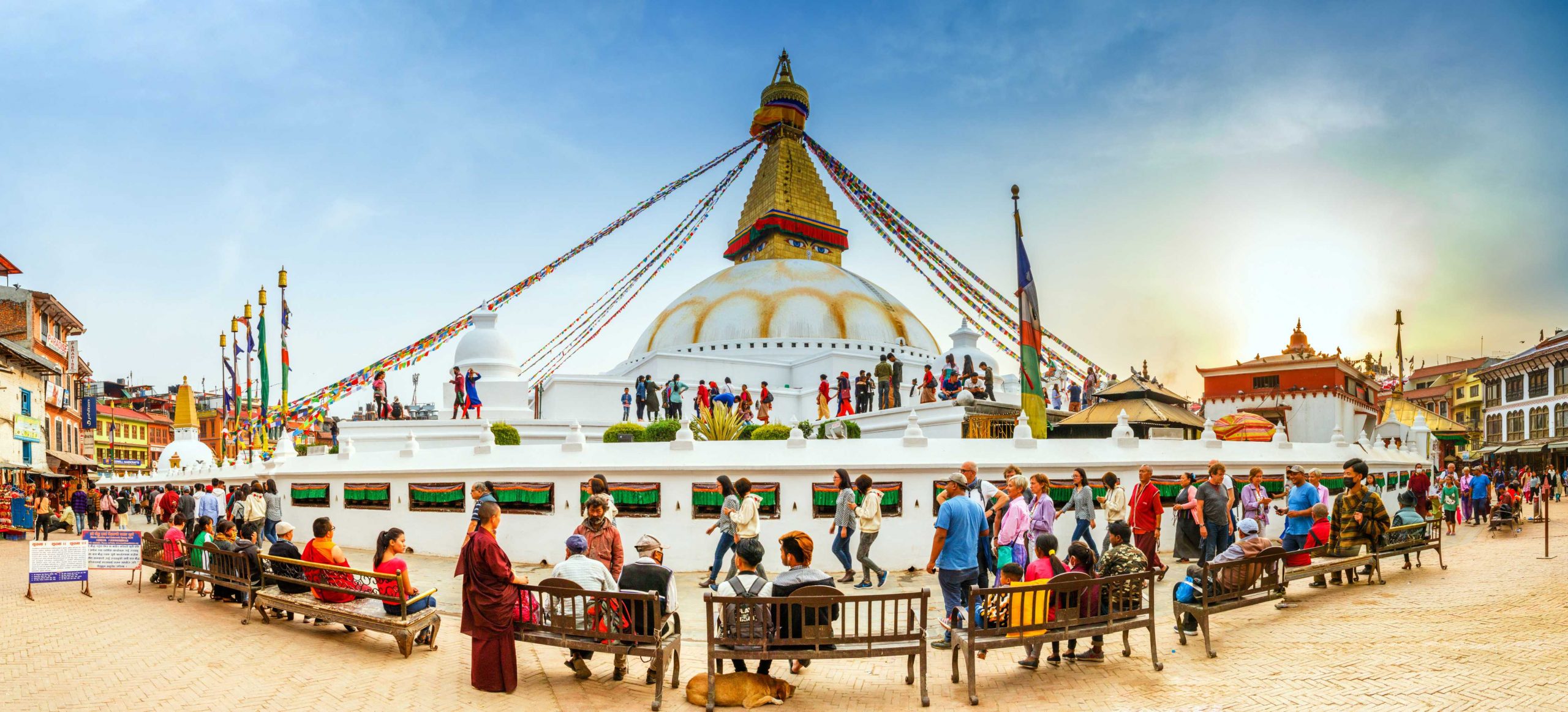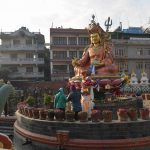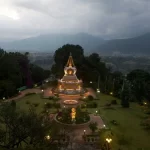Boudhanath Stupa Day Tour
fromBoudha is a Buddhist pilgrimage place, named after its well-known stupa. Devotees attend lectures and prayers at nearby monasteries and schools as they circle the gleaming white dome, which is adorned with painted Buddha eyes. The Boudhanath stupa, along with Swayambhunath, is one of the most well-liked among Buddhists and foreign visitors. It was designated a UNESCO World Heritage site in 1979. It is one of the largest spherical stupas in Nepal due to its enormous Mandala.
One can find stores selling souvenirs, clothing, food from throughout the world, coffee, fruits, and the stupa itself. Thukpa noodle soup, Laphing, Thulo Momo, Shyabhaley, and many other traditional Tibetan dishes are served in some of these neighborhood cafes, while more upscale establishments provide stupa views along with Vietnamese, Korean, Japanese, and Indian culinary choices. Popular local souvenirs include silk thangka paintings, singing bowls, jewelry, and keychains, as well as crystals and ammonite.
-
Reviews 0 Reviews0/5
-
Vacation Style Holiday Type
-
Activity Level Fairly Easy
-
Group Size Medium Group
We will start our tour from the main stupa itself: The Boudhanath Stupa
Boudhanath Stupa

Boudhanath Stupa was a well-liked stopping point for Tibetans traveling between Lhasa and Kathmandu to pray. It was formerly a part of a commerce route. It is now the biggest stupa in all of Asia, a UNESCO World Heritage Site, and a well-liked place of prayer for Tibetan Buddhists in Kathmandu. One of the biggest monasteries in the world, Boudhanath is a place of pilgrimage for Tibetan and Nepalese Buddhists. A mandala is formed when the stupa is seen from above.
At all hours of the day, worshipers surround the stupa, which is viewed from all directions by its all-seeing eyes. As they walk around the stupa, monks and followers occasionally kneel to pray. It’s similar to a racetrack to stroll around it. (In the evening, the stupa is illuminated, and Tibetan yak wax candles are lit in honor of deceased loved ones.) The surrounding area is filled with restaurants and gift shops that you can explore. While waiting, wander the side streets to discover more eateries, monks’ residences, and parks.
We will also turn the Giant Prayer Wheels that are located within the stupa grounds. We will arrive at a secluded worship area after touring the main stupa, where we will observe devotees enter the stupa for a prayer, the ringing of bells, and tikka self-anointing. A room with two enormous prayer wheels is off to the side; you can move with the flow or push the wheel to keep it rolling. Additionally, from here, devotees can access the stupa’s terrace and the inside lining, where they can perform rites involving prostration.
Exiting the Boudhanath Stupa, we will enter the Tamang Gompa monastery.
Tamang Gompa Monastery
 The Tamang Gompa monastery, a two-story monastery, is a simple and lovely monastery to visit at Boudhanath Stupa (you can see it in my video). One of the populations that inhabit and influence Boudha is the Tamang, a native mountain tribe of Nepal. We will find a Giant Prayer Wheel off to the side after passing the monastery gate.
The Tamang Gompa monastery, a two-story monastery, is a simple and lovely monastery to visit at Boudhanath Stupa (you can see it in my video). One of the populations that inhabit and influence Boudha is the Tamang, a native mountain tribe of Nepal. We will find a Giant Prayer Wheel off to the side after passing the monastery gate.
Butter lamps, chanting benches, a huge Buddha with a picture of the Dalai Lama, and an inspired interior layout can all be found inside the monastery. We struggle to stop ourselves from gasping.
Now we will start visiting the neighborhood places of Boudhanath Stupa. We start from the Ghyoilisang Peach Park and Pond.
Ghyoilisang Peace Park and Pond
 The Ghyoilisang Peace Park is located in the area close to Boudhanath Stupa. According to legend, the pond is a holy body of water, and Boudhanath Stupa was built using its soil. Today, it is a calm, quiet park with a massive monument of Guru Rinpoche in the center of an orange carp-filled pond. We’ll discover monks and old folks here, and while we listen to their stories, we’ll be able to retrace our steps through history.
The Ghyoilisang Peace Park is located in the area close to Boudhanath Stupa. According to legend, the pond is a holy body of water, and Boudhanath Stupa was built using its soil. Today, it is a calm, quiet park with a massive monument of Guru Rinpoche in the center of an orange carp-filled pond. We’ll discover monks and old folks here, and while we listen to their stories, we’ll be able to retrace our steps through history.
From the park, we will head to eat something – preferably the foods popular in Boudha. Thereafter, we will resume exploring the neighborhood of this place.
Smaller Monasteries and Temple Stores
We will visit a few of the more than 50 gompas (also known as monasteries) that are located in this area. As a result, the area is filled with fascinating Tibetan Buddhist stores that offer a variety of oddities including incense, singing bowls, horns, and pictures of the Dalai Lama in addition to the temple’s required implements for performing rituals.
Phulbari Street
 At first glance, Phulbari Street (also known as Fulbari Street) seems to be a charming, rural street evoking the old West. But as you go on, the rustic structures give way to more conventional ones and a charming gourmet street filled with stalls selling street food snacks, stores, and restaurants. We’ll come across a bunch of laphing stores and eat some laphing (a meal composed of steamed all-purpose flour).
At first glance, Phulbari Street (also known as Fulbari Street) seems to be a charming, rural street evoking the old West. But as you go on, the rustic structures give way to more conventional ones and a charming gourmet street filled with stalls selling street food snacks, stores, and restaurants. We’ll come across a bunch of laphing stores and eat some laphing (a meal composed of steamed all-purpose flour).
We will roam around some Thangka shops and if you like you can also buy some. We would suggest you buy some prayer flags as well. Those may work as souvenirs or something you can store for yourself.
Our final destination of the day tour is Kopan Monastery. We will board a vehicle and head there.
 Kopan Monastery
Kopan Monastery
A well-known Tibetan Buddhist Gelug monastery, Kopan Monastery offers affordable temple accommodations as well as retreats, courses, and teachings on Buddhism. The monastery was acquired from an astrologer and established in 1969. We’ll spend some time here conversing with the monks to learn more about their beliefs and faith.
From the monastery, we will return, hence completing our day tour.





